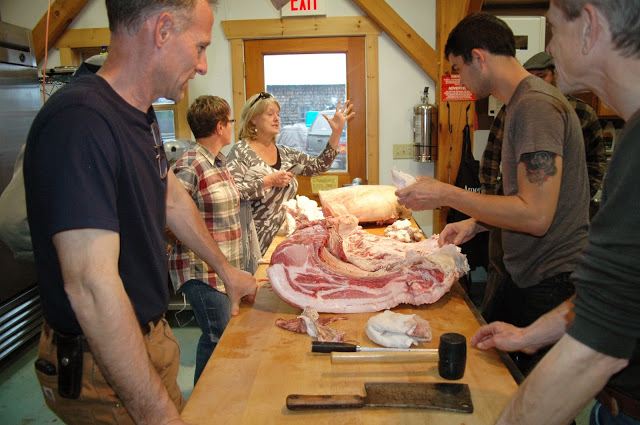
Eating Nose to Tail: Going Whole Hog in Butchery

To take a foods class with Eric Edgin is to be fully immersed in a subject, whether fermentation, butchering meats, or foraging. Whatever their experience level, students are sure to learn about the cultural, ecological, and scientific background of their chosen topic. Eric's students have described him as super knowledgeable, warm, wise, and innovative. Intern Erin sat down with Eric recently to chat about his upcoming butchery, salumi, and meat preservation courses.
Eric, how did you learn about butchery and charcuterie?
I grew up in a really small town, hunting and fishing, so I butchered a lot of small game and deer. More recently, I found I couldn't eat much grains and legumes, so I wanted to build my diet around more meat, but really good quality. And that is expensive. I started buying whole animals and butchering them myself. I read all kinds of books about butchery to learn more, and then by reading and butchering at the same time, learned more and more. I had also been fermenting a lot of vegetables, and making the jump from vegetables to fermenting whole muscle meat [charcuterie style] was not a stretch.
What does good meat mean to you?
I choose meat that is raised outdoors, with access to pasture and foraged foods. Ideally, I want the animal to rotate through different pastures, but I also work with farmers who have less space and can supplement a smaller pasture with a varied diet, including fruit or vegetables and hay. I want the animals to move too, because movement means darker meat, with lots of collagen and fuller flavors. This kind of meat gives me peace of mind, in regards to the animal's life and the environment. But it's also about flavor. It's really hard to go back to commercial pork once you've started eating the good stuff.
Do you have any charcuterie staples that you try to keep around on a regular basis? What are you excited about making next?
I love dry cured pancetta. But I use everything. I've been moving through intestines more slowly but I'm starting to do more dried sausages. Dried sausages are more complicated than whole muscle curing. But they are a much faster process, a few months as opposed to up to a year, and that's really rewarding. I'm really excited about exploring that more.
What's the most exciting part of your butchering classes?
It's really great to be able to custom cut everything. Typically, we can get good meat from places like a co-op or farmer, but they are butchering to get the most cuts of meat possible to sell. We can choose more usual cuts.
What are your favorites?
Roasts are great. I really like cutting shanks up for traditional European ragus. And British bacon is a great cut; it includes the tenderloin as well as the top of the chop, and you can either smoke that or roast it. It's just delicious.
You've got a Pork Butchery for Home Use class coming up again in November. What are some of your favorite things about this class?
I love being able to show people all the things that they can get from a pig. Lots of students come with great questions about the mechanics of butchery, and that leads to great conversations – I aways feel like I learn something from those conversations. Besides the different cuts of meat, we talk about lard, a fat with comparable health benefits to olive oil. And we usually talk about short term preservation and make some terrines and other traditional dishes to really use up the whole animal.
Where's the hog from for this fall's class?
It's being raised outside of Duluth, and I'm helping raise it. It's a mix of different heritage breeds: Red Wattle, Kune Kune, and American Guinea Hog. The Red Wattle is a leaner, fast growing breed, and the other two breeds add some more mass. It's been raised all outdoors, and it eats grass, fallen apples, whatever else we toss in there. It's going to be delicious.
Anything else you want to say to future students?
My goal with all my classes is to leave people well informed and ready to explore a topic more in depth after the class is over. There are so many points of view to come at these [food] topics, including scientific and different culinary traditions. I want to focus on making sure people are really comfortable with the process so that they can go back home and do it on their own. Getting half a hog can feel like a huge, intimidating thing, but I want to make it feel manageable.